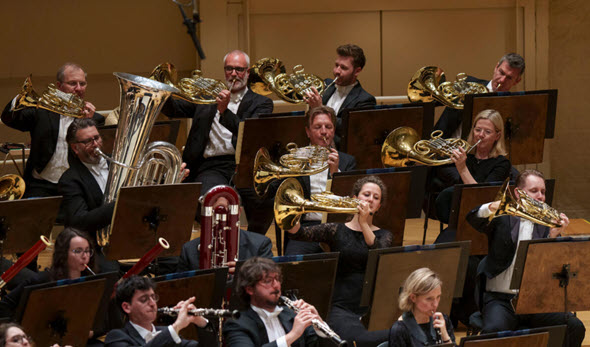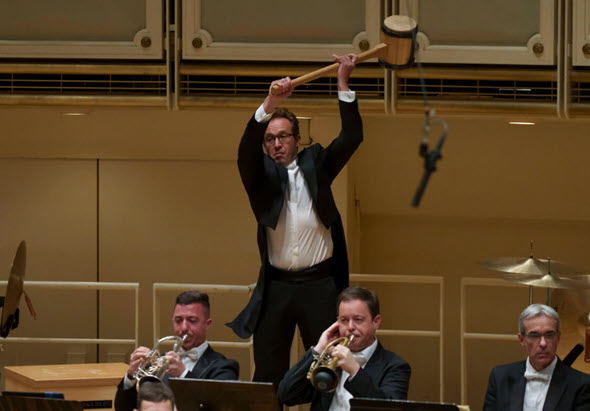Bavarian orchestra’s dark, edged Mahler Sixth bespeaks ascendant composer of modern era

Simon Rattle led the Bavarian Radio Symphony Orchestra in Mahler’s Sixth Symphony at Orchestra Hall. (Todd Rosenberg photos)
Review: Bavarian Radio Symphony Orchestra conducted by Simon Rattle, April 28 at Orchestra Hall.
By Lawrence B. Johnson
From the convergent starbursts of Leonard Bernstein and the vinyl LP, a third supernova was formed: the blazing ascendancy of Gustav Mahler. To be sure, Mahler had always had a smattering of strong and influential advocates on the podium: Willem Mengelberg, Bruno Walter and John Barbirolli notable among them. But it was the charismatic and wholly committed Bernstein, combined with the emergence of stereophonic sound, that ultimately brought Mahler’s massive, fraught but finely crafted symphonies to the general music-loving public. And where is Mahler now? Roll over, Beethoven.
If Mahler hasn’t displaced Beethoven in the hearts – and I might say, lives – of concertgoers, surely that existential composer has pulled up shoulder to shoulder with the author of the “Eroica,” the Fifth, the Ninth. Indeed, these days concertgoers are likely as familiar with Mahler’s Fifth and Ninth symphonies as they are with Beethoven’s. The great Viennese composer Alban Berg, upon hearing Mahler’s Sixth Symphony not long after its premiere in 1906, declared it “the only Sixth,” Beethoven’s “Pastoral” notwithstanding.
It was a performance of the Mahler Sixth, by the Bavarian Radio Symphony Orchestra led by Simon Rattle at Orchestra Hall, that brought this new-age reality crashing to mind. While the Munich-based ensemble – by its German moniker the Symphonieorchester des Bayerischen Rundfunks – is a first-rate orchestra, it isn’t all that well known in the U.S., certainly not to the degree that popping into Chicago to play one work would fill Orchestra Hall virtually top to bottom, including the choral terrace behind the stage.
To be sure, the 69-year-old Rattle, in his first season as principal conductor of the Bavarian Radio Symphony, is an international star, having served as artistic director and chief conductor of the Berlin Philharmonic from 2002-18. Yet the cosmic magnetism here surely resided in the work itself: an 80-minute narrative without words, a tragedy of spirit in four acts that begins and ends in desolate A minor. More Sartre than Shakespeare, the Sixth is a masterpiece of modernist theater, dark and convulsive and yet riven with ardent, searing lyricism. As a musical composition, it’s also as brilliant as it is bleak. All of these qualities shone in the Bavarian orchestra’s burnished playing.
The Sixth Symphony calls for an expanded orchestra with double woodwinds, eight French horns, two harps and a percussion group that famously includes a giant sledgehammer that twice brings down an inauspicious augury of man’s fate. Like Rattle, who conducted without the distraction of a printed score, the orchestra manifestly knows this complex music to its core – its heavy tread and its lightness of being, its massive sonorities and its consummate finesse.
Here was a performance of wonderful character and variety, from the brash striding that opens the work to the dazzling contrapuntal weave that animates the long, turbulent finale. While this is Rattle’s first season as commander in chief, his association with the Bavarian Radio Symphony goes back decades. Just how well they know each other was evident in his reticent conducting. Only when the music turned dense and technically fraught was his stick prominently up; other times, his leadership was almost laissez-faire. But the effect was invariably precise, cleanly sculpted, riveting.
A central issue of any go at the four-movement Sixth is the order of the two middle movements, Andante and Scherzo. Mahler conceptualized the symphony with the Scherzo coming after the opening movement, elaborating Its thematic elements and harmonic motifs. But that also means the driving rhetoric of the opening starts, as it were, all over again with the tumultuous Scherzo. For reasons he apparently never articulated, Mahler reversed himself and placed the respite of the radiant Andante ahead of the Scherzo; then he changed his mind again. Conductors have always been divided on the issue, though among the many recordings perhaps two-thirds observe Scherzo-Andante.
Rattle has recorded the work twice, both times preferring the Andante’s stress relief before the Scherzo. To my amazement, the printed program showed Scherzo/Andante – but that’s not what happened. As usual, the conductor placed the Andante second. That sequence, one might argue, also works to the benefit of the Scherzo, a bravura composition that can be much better appreciated when set apart from the opening movement. Moreover, Rattle tied the Scherzo to the finale by taking almost no pause between the two movements: The shuddering upward sweep that opens the finale thus seemed to emerge from the Scherzo’s quiet expiration.
If many in the audience didn’t know the Bavarian Radio Symphony before this concert, they assuredly do now. The applause after 80 minutes of music was thunderous and long. Even after Rattle made his final exit and the musicians began clearing their scores, the standing ovation continued unabated. It was bizarre to observe, if perfectly understandable. All that was missing was for Rattle to hold up the conductor’s score to honor the work itself. But the occasion had already bestowed that honor; and besides, he didn’t have a score.




